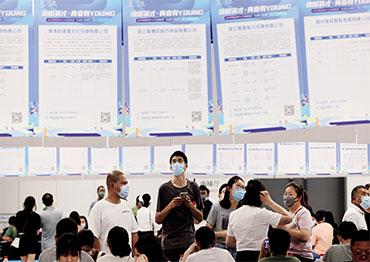In the past few months, the Chinese government launched measures to stabilize the economy and boost the job market. In February, China’s top economic planner, the National Development and Reform Commission (NDRC) outlined 43 measures to support the service sector, mainly through tax and fee reductions for companies.
At the end of May, the State Council unveiled a policy package to stabilize the economy, which listed 33 measures including expanding the scale of tax and fee reductions, increasing fiscal expenditure, speeding up the issuance of the 3.45 trillion-yuan (US$510b) special bond quota, increasing infrastructure spending, boosting consumption, providing loan support to small and micro businesses and lowering the cost of financing.
According to Liu Xiaoguang, a research fellow at the National Academy of Development and Strategy at the Renmin University of China in Beijing, the policy packages provide vital support to the service sector and could boost employment in the following months. “Accounting for about half of China’s economy, the service sector is the foundation of the stability of urban employment and a driver of new jobs,” Liu said.
Liu said as Covid-related control measures are gradually phased out and the stimulus policies start to take effect, the service sector may witness a turning point in the latter half of 2022, which would help drive down unemployment rates.
In the past months, governments in several localities launched measures to increase job vacancies in the State sector. In late May, Shanghai government released a notice requiring SOEs under its jurisdiction to allocate no less than 50 percent of its job vacancies to fresh college graduates. The government of Shandong Province pledged to reserve 60 percent of its SOE vacancies for recent college graduates.
But as the State sector, including government agencies and SOEs, only accounts for about 20 percent of the labor force, the impact of these measures will be limited, said Professor Lu Feng.
During a press conference on June 14 in Beijing, Xu Xiaolan, vice minister at the Ministry of Industry and Information Technology, told media that the key to solving the unemployment problem is to protect the development of China’s small- and medium-sized enterprises (SMEs). Xu said that by the end of 2021, 99 percent of China’s 48.42 million companies were SMEs, which account for 80 percent of urban jobs.
According to an analysis of recent business registry data conducted by Zeng Xiangquan, director of the China Institute for Employment Research at the Renmin University of China, the ratio between the number of newly registered small and micro businesses and those that deregistered declined to 0.88 in 2021, the first time the index has dropped into the contraction zone, measured with a reading below 1 in the index. While the figure recovered slightly to reach 0.94 in March, it still shows an overall contraction in the sector.
On July 31, the NBS released data showing that the Purchasing Managers’ Index (PMI), a measure of trends in manufacturing, for large, medium-sized, and small companies was 49.8 percent, 48.5 percent, and 47.9 percent for July, all of which are in the contraction range, with small businesses performing the worst.
In an article released in March, Professor Liu Yuanchun, president of the Shanghai University of Finance and Economics, warned that the government should be aware that measures to stabilize the overall economy, which focus on critical industries, big companies and keynote projects, may not be as effective in supporting SMEs, which are key to stabilizing the job market.
Liu Yuanchun pointed out that although the government has taken measures to stabilize the economy, including tax and fee reductions for SMEs, the much desired “trickle-down effect” has not taken place.
Liu argued the biggest challenge SMEs face is lack of cash flow and uncertainty over future business prospects. Reducing taxes and fees alone cannot solve their problems. He said the government should take a more proactive approach to support them, including direct financial support and subsidies.
The State Council’s policy in May for job market of graduates promised support for graduates, including more jobs at SMEs and SOEs, better treatment for graduates to work in less developed areas and incentives for graduate-led business startups.

 Old Version
Old Version


